PPC Ads For Plastic Surgeons: How To Win More High-Quality Surgery Leads
PPC for plastic surgeons is a proven strategy to get more high-quality Surgery leads. But only if you do it right way. This an ultimate Plastic Surgery PPC guide to help to get more high-quality surgery leads without spending or wasting more money.
Published on March 15, 2025
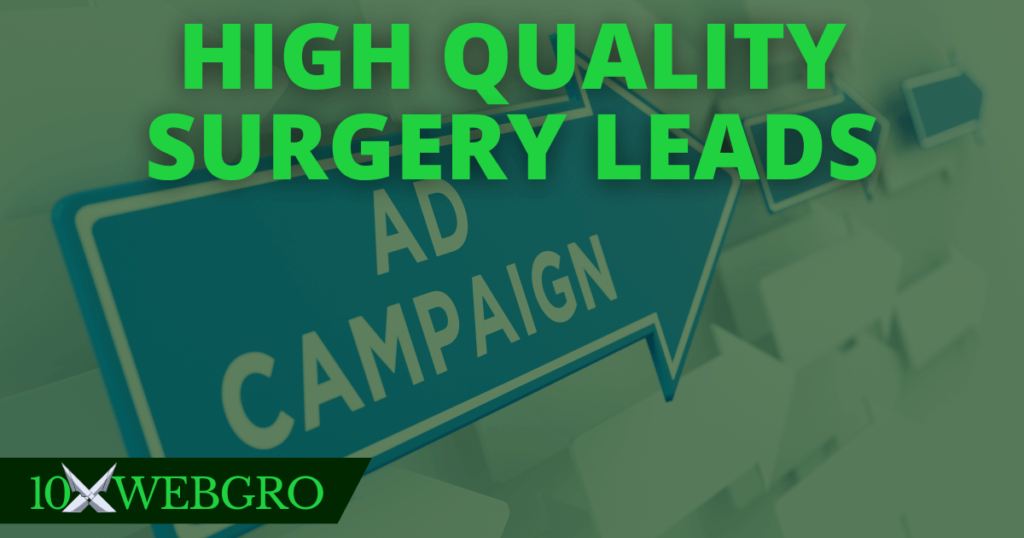
1. Understanding Plastic Surgery PPC
2. Why Plastic Surgeon run PPC Ads?
3. Plastic surgery PPC results
4. Ultimate step-by-step guide to build a successful Plastic Surgery PPC Campaign
Step 1: Keyword Research: Finding the Right Terms
Step 2: Targeting the Right Audience
Step 3: Crafting Effective Ad Copy
Step 4: Optimizing Landing Pages for Conversions
Step 5: Google Ad Campaign Setup
Step 6: Ad Extensions: Enhancing Visibility and Engagement
Step 7: Tracking and Reporting Campaign Performance
Step 8: A/B Testing Campaign Elements
Step 9: Scaling Winning Keywords
5. Fill your pipeline with qualified surgery leads using plastic surgery PPC
When people think about getting plastic surgery, where do they go first? Almost always, it’s Google.
So, what’s the first thing they see when they begin their search?
Pay-per-click (PPC) ads, those top-of-the-page listings that grab attention right away.
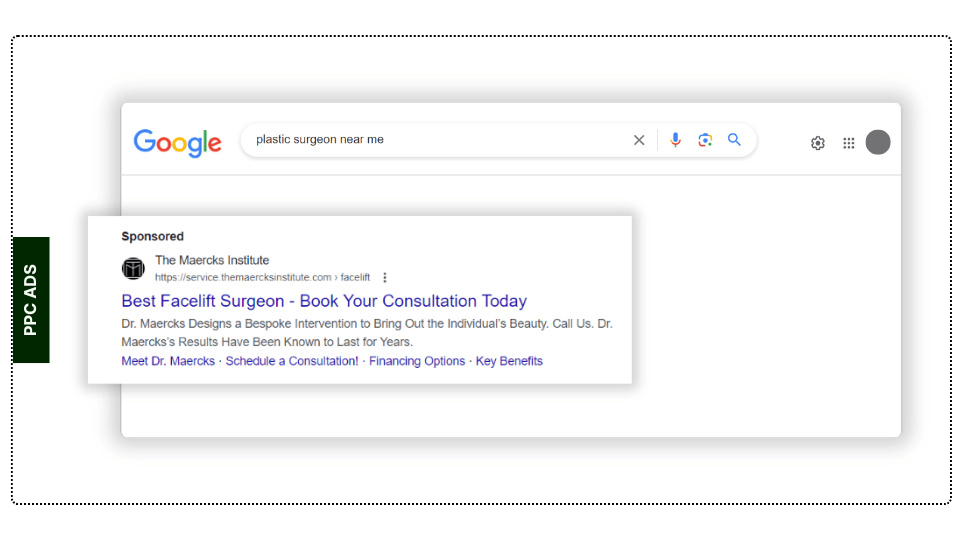
There’s a reason why plastic surgeons spend tens of millions of dollars annually on Google PPC ads — it works.
These ads are front and center, reaching potential patients at the exact moment they’re searching for services like yours.
But let’s face it, while the potential is huge, many plastic surgeons struggle to make PPC ads work profitably.
Without the right strategy, you could end up with thousands of clicks from people who aren’t serious about booking surgery, costing you money without filling your pipeline with quality leads.
Here’s the reality: Getting lots of clicks is not the goal. Getting the right clicks from people ready to schedule consultations and surgeries is what really matters. And that’s where understanding how to use PPC ads effectively comes in.
PPC is a proven method for generating high-quality surgery leads, but only if you know how to set up and manage your campaigns the right way. By learning the ins and outs of PPC for plastic surgeons, you can turn those clicks into actual patients, growing your practice efficiently and profitably.
Understanding Plastic Surgery PPC?
PPC stands for pay-per-click, a model of online advertising where you pay each time someone clicks on your ad. Google Ads is one of the most popular platforms using the PPC model.
It allows businesses, including plastic surgery centers, to bid on keywords relevant to their services. When someone searches for those keywords, your ad appears at the top of the search results.
Here’s how it works: You choose specific keywords that potential patients might use when searching for plastic surgery services. Then, you set a bid, which is the maximum amount you’re willing to pay for each click on your ad.
The higher your bid and the more relevant your ad, the more likely your ad will show up in top positions.
For plastic surgeons, PPC is a powerful tool. It puts your practice in front of people who are actively searching for your services, driving targeted traffic to your website. By understanding and effectively using PPC, you can attract more qualified leads, ultimately growing your practice.
Why Plastic Surgeon run PPC Ads?
PPC, or pay-per-click advertising, has become a vital tool for plastic surgeons. Many plastic surgery centers rely on PPC to reach potential patients right when they’re searching for cosmetic procedures.
The demand is there—thousands of people are searching for plastic surgeons on Google every day.
But here’s the catch: your competitors are there too, vying for the same patients.
Many plastic surgery centers struggle to gain traction with PPC campaigns. Some adopt a slow-burn strategy, spending money without seeing significant results, while others abandon PPC altogether, deeming it a waste of time and money. But this couldn’t be further from the truth.
When PPC is done wrong, it can attract the wrong traffic, people who aren’t serious about booking a consultation. But when it’s done right, PPC ads target those who are actively searching for plastic surgery and are ready to book now.
Nothing delivers warm or even hot leads quite like a well-managed PPC campaign.
It’s hard to miss your plastic surgery center when appearing here, hear, or hear:
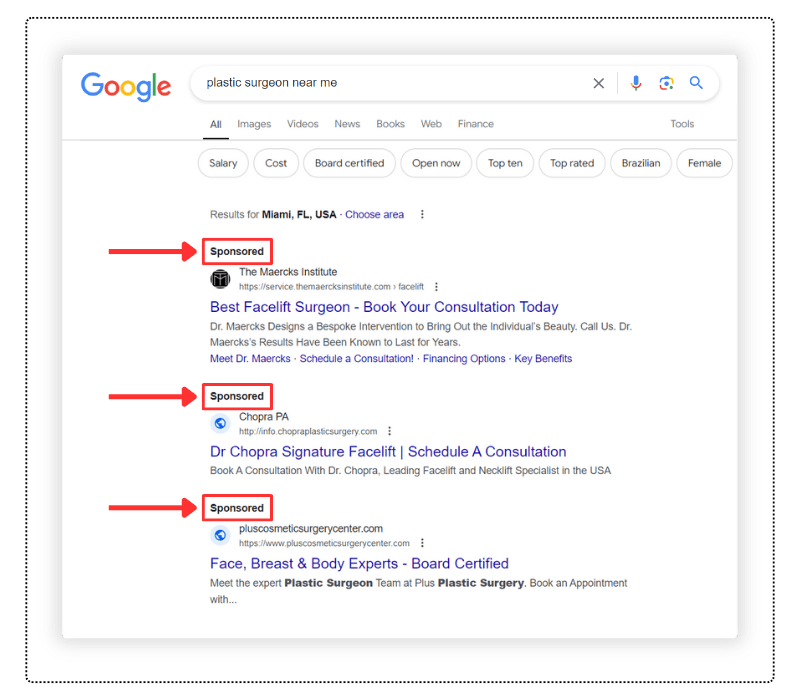
Imagine your plastic surgery center dominating each ad section on Google’s search engine results page (SERP) for your chosen keywords.
That’s the level of visibility a successful PPC strategy can provide. And that’s the goal we’ll help you reach.
We understand that many plastic surgeons have been burned by PPC agencies in the past. We get it—trust isn’t given; it’s earned.
Fair enough.
Plastic surgery PPC results
The results of your plastic surgery PPC campaigns can vary widely based on several key factors.
Your practice area—whether you’re a facial plastic surgeon, hand surgeon, or specialize in cosmetic and reconstructive surgery—plays a significant role in determining the kind of leads and conversions you’ll generate.
Additionally, your geographic location and the keywords you target are crucial in shaping your campaign outcomes.
To give you an idea of how these factors influence results, let’s take a look at two different locations in the U.S. For example, targeting a long-tail keyword in Miami might bring you around 901 clicks and 90 conversions per month, translating to a 10% conversion rate.
In contrast, targeting the same type of keyword in Gainesville could yield only 100 clicks and 10 conversions per month, though with the same 10% conversion rate.
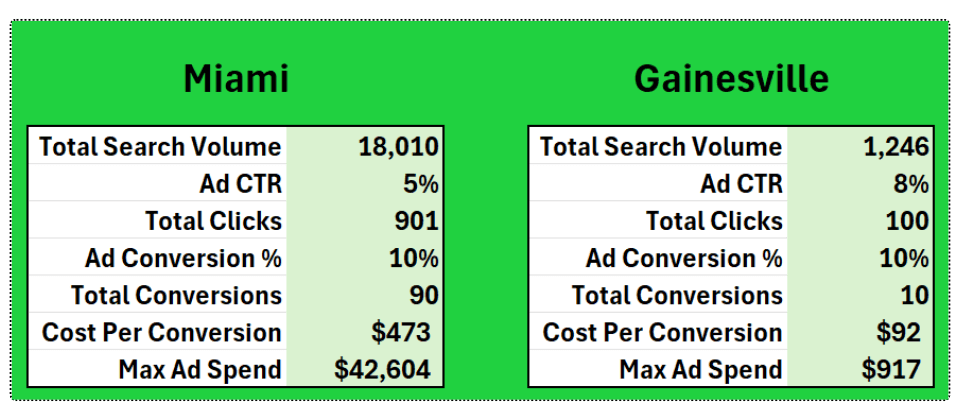
The difference? Miami is a major city with a larger market, while Gainesville serves a smaller community. As expected, the cost per conversion in Miami is higher—$473 compared to $92 in Gainesville.
However, while location heavily influences your PPC campaign’s performance, it’s not entirely outside your control.
There are strategies you can implement to optimize your results across different markets. By refining your keyword strategy, adjusting your bids, and enhancing your ad copy, you can achieve better outcomes and make the most of your PPC investment, regardless of where your practice is located.
We’ll guide you through these strategies to help you get the best possible results from your PPC campaigns.
Ultimate step-by-step guide to build a successful Plastic Surgery PPC Campaign
1. Keyword Research: Finding the Right Terms
2. Targeting the Right Audience
3. Crafting Effective Ad Copy
4. Optimizing Landing Pages for Conversions
5. Google Ad Campaign Setup
6. Ad Extensions: Enhancing Visibility and Engagement
7. Tracking and Reporting Campaign Performance
8. A/B Testing Campaign Elements
9. Scaling Winning Keywords
Step 1: Keyword Research: Finding the Right Terms
Effective keyword research is the cornerstone of any successful PPC campaign. It’s different from SEO keyword research, especially in the context of plastic surgery, where the competition is fierce, and patient needs are specific.
By conducting deep market analysis, you can understand your target audience, identify your competitors, and define your unique value proposition.
This forms the foundation of your keyword list, ensuring that your PPC campaign is not just reaching people but reaching the right people.
Understanding Search Intent
When potential patients consider plastic surgery, they search online with specific intentions, whether they’re researching procedures, looking for reviews, or ready to book a consultation.
Understanding these intentions is key to targeting the right keywords. For example, someone searching “best rhinoplasty surgeon near me” is likely at the decision-making stage, whereas a search like “what is rhinoplasty” might indicate they’re still in the research phase.
By analyzing search intent, you can categorize keywords into different stages of the patient journey, allowing you to craft ads that meet them where they are and guide them toward conversion.
Utilizing Keyword Research Tools
To find the best keywords for your PPC campaign, tools like Google Keyword Planner or SEMrush are invaluable. These platforms allow you to uncover high-volume keywords with low competition that are relevant to your services.
For plastic surgeons, this might include terms like “breast augmentation cost in miami” or “facelift before and after.” By leveraging these tools, you can identify which keywords are worth bidding on and which ones are too competitive, helping you optimize your ad spend and target the most valuable search terms.
Use Long-Tail Keywords
Long-tail keywords are longer, more specific phrases that often have lower search volumes but higher conversion rates.
For plastic surgeons, these might include terms like “Tampa Mommy Makeover” or “best Beast Augmentation Plastic Surgeon in Florida.” While these keywords may attract fewer clicks, the people who do click are more likely to be serious about booking a consultation.
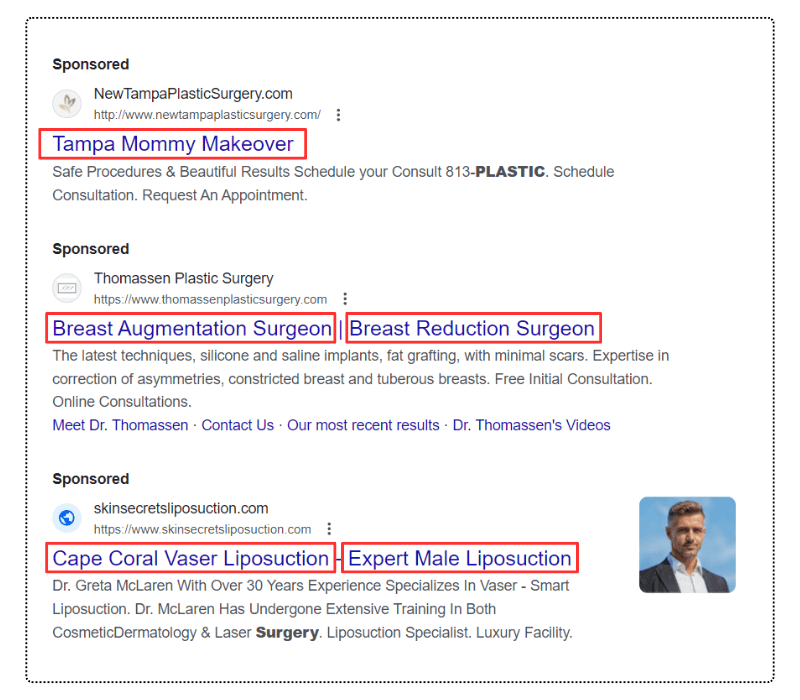
Additionally, long-tail keywords are typically less expensive to bid on, allowing you to stretch your budget further and increase your return on investment. By focusing on these niche terms, you can attract highly qualified leads and reduce wasted ad spend.
Step 2: Targeting the Right Audience
A successful PPC campaign for plastic surgeons requires more than just great keywords; it also demands precise audience targeting.
Understanding who your ideal patients are and where to find them online will significantly increase the effectiveness of your ads. Here’s how to target the right audience:
Demographic Targeting
The first step in targeting your ideal audience is understanding who they are. Demographic targeting allows you to reach potential patients based on age, gender, income level, and geographic location.
For example, if you specialize in procedures like facelifts or tummy tucks, your ideal patient might be women aged 35-60 with a higher income level. Knowing this, you can tailor your PPC ads to appear to this specific group.
Geographic location is also crucial, especially in plastic surgery, where patients often look for services close to home.
By targeting ads to specific zip codes or cities where your center is located, you ensure that your ads reach people who are more likely to convert.
Behavioral Targeting
Behavioral targeting involves using data on past patient interactions to predict who is most likely to need your services. For example, if someone has visited your site multiple times, looked at several procedure pages, or read your blog posts, they’re showing strong interest in what you offer. These behaviors indicate that they may be closer to making a decision.
By leveraging this data, you can create targeted ads that speak directly to these high-intent individuals. For instance, if a visitor frequently checks out your rhinoplasty content, you can target them with ads highlighting a special offer on rhinoplasty consultations.
This level of personalization increases the chances of conversion because the ads are more relevant to the user’s specific interests and needs.
Remarketing Strategies
Even with the best targeting, not everyone who visits your site will convert on their first visit. That’s where remarketing comes in. Remarketing allows you to re-engage users who have previously interacted with your site but didn’t take action.
By showing them customized ads as they browse other sites or social media, you can remind them of your services and encourage them to return.
For example, if a visitor left your site after viewing your consultation booking page, you could use remarketing ads offering a limited-time discount on consultations to bring them back.
Remarketing is highly effective because it targets individuals who are already familiar with your brand, making them more likely to convert on their next visit.
By strategically combining demographic targeting, behavioral targeting, and remarketing, you can create a PPC campaign that not only reaches your ideal audience but also engages them in a way that drives conversions.
This approach ensures that your ad spend is directed toward the people who are most likely to become your patients, maximizing your return on investment.
Step 3: Crafting Effective Ad Copy
When it comes to search engine ads, simplicity is key. There are no flashy images or videos to capture attention—just a few lines of text.
But don’t let that fool you; these few lines can make all the difference in whether someone clicks on your ad or scrolls past it.
The success of your PPC campaign hinges on your ability to craft ad copy that not only captures attention but also persuades potential patients to take action. Here’s how to make every word count:
Highlighting Patient Benefits
Your ad copy should focus on what matters most to your potential patients—the benefits they’ll receive from choosing your services.
It’s tempting to list all the features of your practice, like years of experience or the latest technology you use. While those are important, they don’t directly speak to what the patient is looking for. Instead, highlight how your services will improve their lives.
For instance, instead of saying, “We offer advanced rhinoplasty techniques,” try something like, “Achieve the nose shape you’ve always wanted with our personalized rhinoplasty treatments.”
This approach directly addresses the patient’s desire and positions your service as the solution to their problem. By focusing on the outcome the patient will experience, you make your ad more appealing and relevant to their needs.
Incorporating Emotional Triggers
Emotions play a significant role in decision-making, especially when it comes to something as personal as plastic surgery. Your ad copy should tap into these emotions by addressing common pain points and desires.
Are your potential patients self-conscious about a specific feature? Do they feel like they’re not aging gracefully? Use language that resonates with these feelings and offers a solution.
For example, an ad that says, “Regain your confidence with our expert facelift procedures,” speaks directly to the emotional benefits of the service. It’s not just about getting a facelift; it’s about feeling better about oneself.
By using emotional triggers in your copy, you can connect with potential patients on a deeper level, making them more likely to choose your practice over others.
Strong Calls to Action (CTAs)
A well-crafted PPC ad always ends with a compelling call to action (CTA). The CTA is what tells the reader what to do next—whether it’s booking a consultation, calling your office, or filling out a form. Without a clear and strong CTA, even the most persuasive ad copy can fall flat.
Your CTA should be direct and create a sense of urgency. Phrases like “Book Your Consultation Today” or “Schedule Your Appointment Now” encourage immediate action.
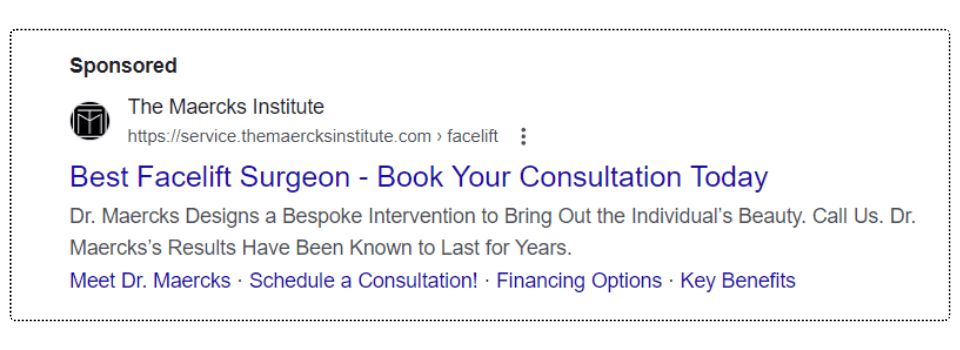
The goal is to make it as easy as possible for the potential patient to take the next step. A strong CTA not only drives conversions but also reinforces the value of your service by reminding the reader of the benefits they’ll receive.
Step 4: Optimizing Landing Pages for Conversions
The ad may bring potential patients to your website, but it’s the landing page that will ultimately convert them into paying clients. A well-designed landing page is crucial for turning those clicks into appointments.
Let’s break down the key elements needed to optimize your landing pages for maximum conversions.
Create Dedicated Landing Pages
One size doesn’t fit all when it comes to landing pages. To get the best results from your PPC campaigns, you should create dedicated landing pages tailored to each specific market or ad group.
For example, here’s a landing page for facelift plastic surgeon in Sarasota:
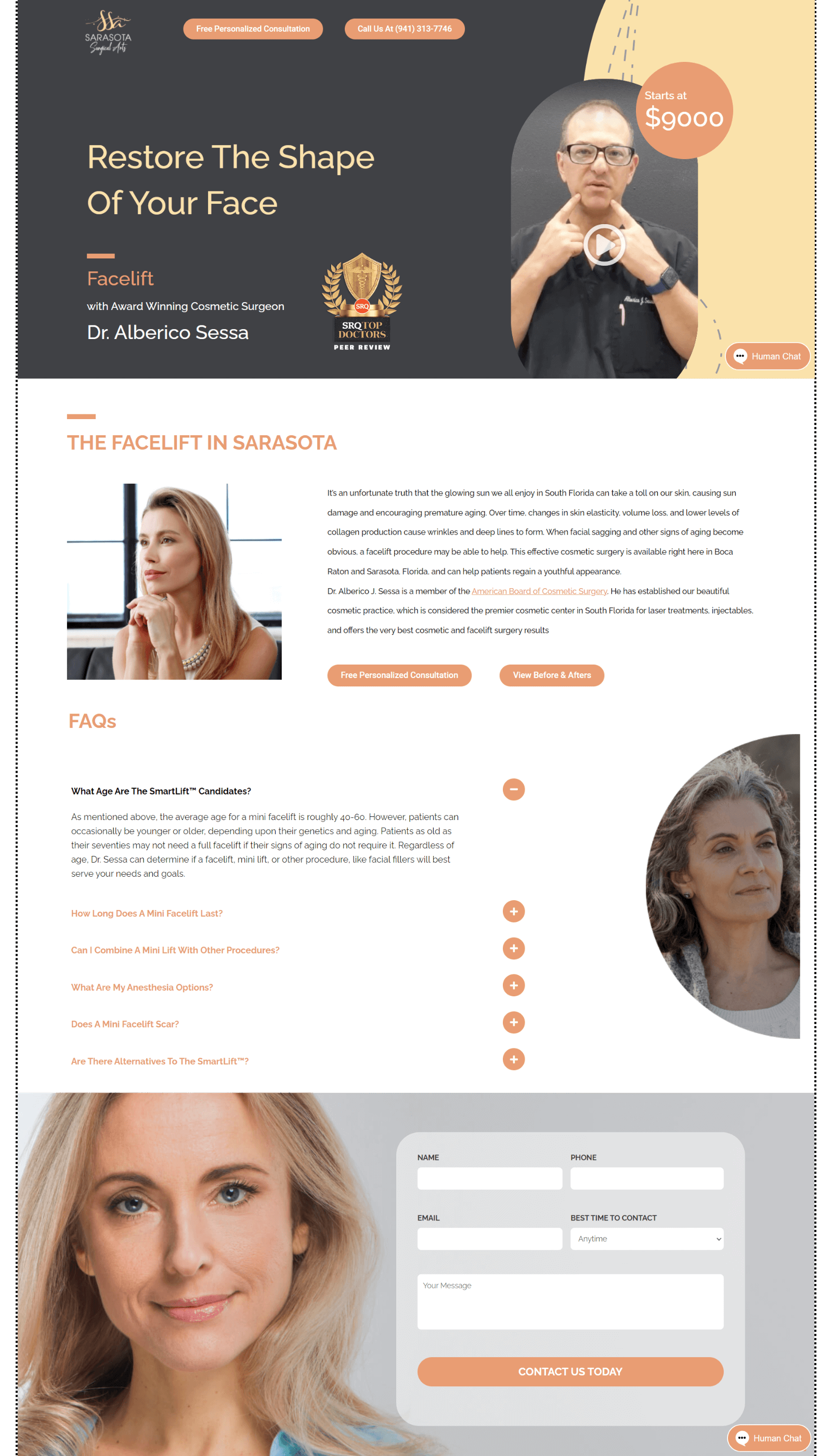
This means if you’re running ads for rhinoplasty, the landing page should be entirely focused on that service. A dedicated landing page ensures that visitors find exactly what they’re looking for when they click on your ad, minimizing any friction in their journey.
Having a dedicated landing page also allows you to customize the content, design, and call-to-action (CTA) to match the specific needs and expectations of the target audience.
For instance, if you’re targeting a younger demographic interested in cosmetic enhancements, your landing page can feature youthful design elements, vibrant colors, and language that resonates with that audience.
On the other hand, if your ads are focused on more mature individuals seeking reconstructive surgery, the tone and imagery should reflect a more professional and compassionate approach.
A Conversion-Optimized Landing Page
A conversion-optimized landing page is one that seamlessly matches the promise made in your PPC ad, ensuring a smooth and coherent transition for users.
The headline should be compelling and directly aligned with the ad’s messaging, reassuring visitors that they’ve landed in the right place. Engaging visuals, such as before-and-after photos, can also play a crucial role in capturing attention and building trust.
One of the most powerful tools for driving conversions is social proof, such as strong testimonials or patient reviews. Featuring testimonials from satisfied patients who have undergone the same procedure can help alleviate any concerns and encourage new visitors to take the next step.
Additionally, it’s a must to include clear and prominent CTAs, like “Schedule Your Free Consultation,” to guide users towards making a decision.
In today’s mobile-first world, it’s also vital to prioritize mobile responsiveness and fast loading times. A landing page that’s optimized for mobile devices not only provides a better user experience but also reduces bounce rates, helping you capture leads from all types of devices.
Testing Landing Page Elements
Optimization doesn’t stop once the landing page is live. Continuous testing of different elements on your landing page is essential to ensure you’re getting the best possible conversion rates.
A/B testing, where you compare two versions of a page with slight variations, is a proven method for determining which elements work best. You can test different headlines, images, CTAs, and even the layout of the page to see what resonates most with your audience.
Testing allows you to gather data-driven insights and make informed decisions about how to improve your landing page over time. For example, if you find that a certain CTA color leads to more clicks, or that a testimonial placed higher on the page boosts conversions, you can make those changes permanent.
The goal is to create a landing page that not only attracts visitors but also compels them to take action.
Step 5: Google Ad Campaign Setup
Setting up a Google Ad campaign requires careful planning and strategy to ensure you’re reaching the right audience and getting the best return on your investment.
Choosing the Right Campaign Type
The first step in setting up your Google Ad campaign is choosing the right type of campaign. Google offers several options, including search ads, display ads, and video ads. Each type has its strengths, depending on your goals and the behavior of your target audience.
Search Ads are the text-based ads that appear at the top of Google search results when someone searches for a keyword related to your services. Search ads are ideal if you want to capture people who are actively searching for plastic surgery services.
Display ads appear on websites across the Google Display Network, which includes millions of websites, apps, and videos.
If you want to engage your audience with visual storytelling, video ads on platforms like YouTube can be very effective.
Choosing the right campaign type depends on what you want to achieve. Most Plastic Surgery Center wants to drive immediate inquiries, so you should select search ads.
Setting Up Ad Groups
Once you’ve chosen your campaign type, the next step is to organize your campaign into ad groups.
Ad groups allow you to structure your campaign around different procedures, patient demographics, or keywords. This structure enables more precise targeting and messaging.
For instance, if you offer a range of procedures like rhinoplasty, liposuction, and breast augmentation, you can create separate ad groups for each. This way, each ad group can have tailored keywords, ad copy, and landing pages that speak directly to the needs and concerns of the audience interested in that specific procedure.
Create ad groups for each major procedure you offer. Each group should target specific keywords related to that procedure and use ad copy that highlights the benefits of that particular service.
You can also set up ad groups based on the demographics of your ideal patients. For instance, if you’re targeting younger women for cosmetic procedures or older men for reconstructive surgery, create ad groups that speak directly to those audiences. Tailor your messaging to their specific needs and concerns.
By setting up well-organized ad groups, you can ensure that your ads are more relevant to the searcher, which can improve your click-through rate (CTR) and conversion rate.
Defining Budget and Bids
Budgeting and bidding are critical components of your Google Ad campaign. Your budget determines how much you’re willing to spend, while your bids influence how competitive your ads are in the auction process.
Start by determining your overall budget for the campaign, then allocate it across your ad groups based on your priorities. For example, if rhinoplasty is a high-demand service in your area, you might want to allocate a larger portion of your budget to the rhinoplasty ad group.
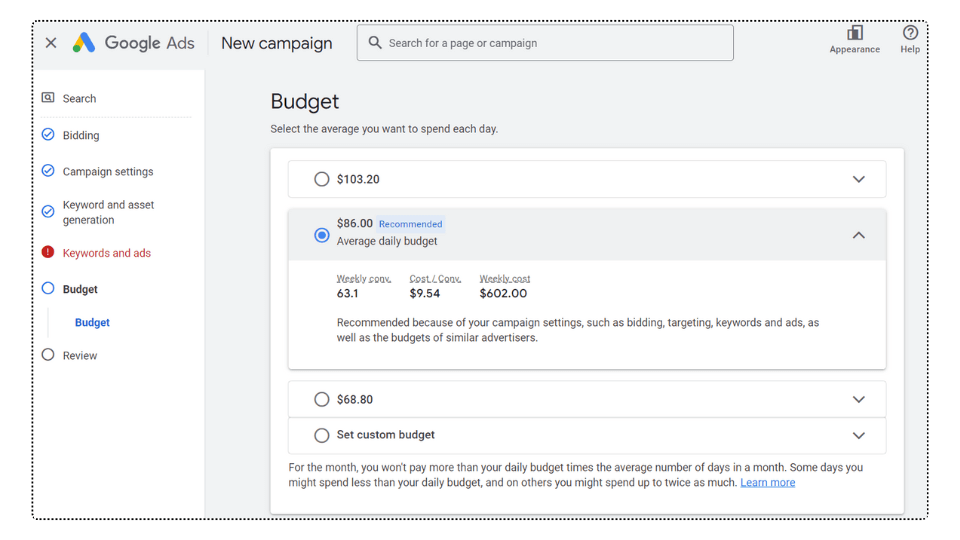
Ensure you’re not spreading your budget too thin across too many ad groups, as this can dilute the effectiveness of your campaign.
Google Ads operates on a bidding system where you set the maximum amount you’re willing to pay for a click on your ad.
Consider using automated bidding strategies, such as “Maximize Conversions” or “Target CPA,” which allow Google to adjust your bids based on your campaign goals.
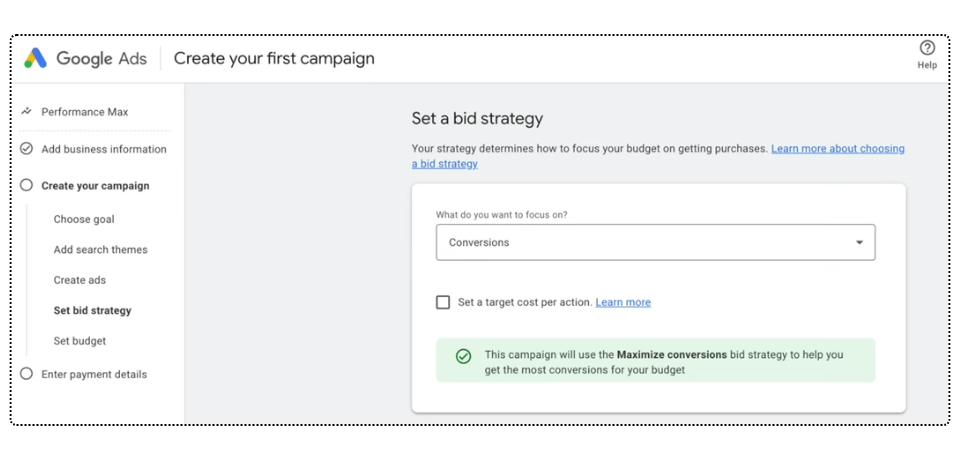
Once your campaign is live, monitor its performance regularly. Keep an eye on key metrics like CTR, conversion rate, and cost per conversion.
Step 6: Ad Extensions: Enhancing Visibility and Engagement
When running a PPC campaign for your plastic surgery practice, using ad extensions can significantly enhance the visibility and effectiveness of your ads.
Utilizing Site Link Extensions
Site link extensions are a powerful way to add more depth to your PPC ads. Instead of just directing users to your homepage, site link extensions allow you to add multiple links within your ad that lead to specific pages on your website.
This can include links to your consultation booking page, patient testimonials, or a gallery of before-and-after photos.
With site link extensions, you can guide potential patients to the most relevant pages on your site, based on their needs.
Adding site link extensions not only makes your ads more useful but also improves their performance. Ads with site link extensions tend to have higher click-through rates (CTR) because they offer more options for users to explore.
Plus, site link extensions increase the size of your ad, making it more noticeable on the search results page.
Consider your campaign goals when setting up site link extensions. If your goal is to increase consultations, prioritize links to your booking page or special offers. If you want to build trust, include links to patient reviews or credentials.
Implementing Call Extensions
Call extensions are a must-have for any plastic surgery practice running PPC ads.
These extensions allow potential patients to call your office directly from the ad with just a click, making it easier for them to take immediate action.
Call extensions can significantly boost engagement, especially on mobile devices. When users are searching for a plastic surgeon, they often want to speak with someone right away.
By providing a direct call option, you reduce the friction between interest and action, leading to more inquiries and consultations.
One of the benefits of using call extensions is the ability to track phone calls. Google Ads allows you to monitor how many calls your ad generates, helping you measure the effectiveness of your campaign.
You can even set up call tracking to record how long the calls last, giving you insights into the quality of the leads your ads are producing.
To maximize the effectiveness of call extensions, consider scheduling them to appear only during your office hours. This ensures that potential patients can reach you when someone is available to take their call.
Adding Location Extensions
Location extensions are another essential tool for plastic surgery practices.
These extensions include your center’s address, a map, and even the distance from the user’s location, making it easy for local patients to find you.
Location extensions are particularly useful for attracting local patients who are searching for a plastic surgeon nearby.
Whether someone is searching for “plastic surgeon near me” or looking for directions, having your location featured in your ad streamlines their journey to your door.
Step 7: Tracking and Reporting Campaign Performance
A successful PPC campaign doesn’t end when the ads go live; it’s an ongoing process that requires careful tracking and analysis to ensure you’re getting the best return on your investment.
Setting Up Conversion Tracking
The first step in setting up conversion tracking is to identify which actions matter most to your business.
For a plastic surgery center, this could include actions like booking a consultation, filling out a contact form, or making a phone call. By focusing on these key conversions, you can measure the true impact of your ads on your business.
Google Ads offers built-in conversion tracking tools that can be easily implemented on your website. These tools give you real-time data on how users are interacting with your site and what actions they’re taking.
Reporting and Adjusting
Regular reporting and adjusting of your PPC campaign is essential for long-term success.
Use the data from your conversion tracking and key metrics analysis to create detailed reports.
These reports should include insights into which ads are performing well, which keywords are driving the most conversions, and how your budget is being spent.
Once you have your report, it’s time to make adjustments. If certain ads or keywords are underperforming, consider reallocating your budget to higher-performing areas.
Step 8: A/B Testing Campaign Elements
A/B testing, also known as split testing, is an essential part of optimizing your PPC campaigns.
Testing Ad Copy Variations
A/B testing different variations of your ad copy can help you find the most effective messaging.
The headline is the first thing people see, so it’s important to test different approaches.
For instance, you might try a headline that emphasizes affordability (“Affordable Plastic Surgery in Your Area”) against one that highlights expertise (“Board-Certified Plastic Surgeons with Years of Experience”).
Similarly, in the description, you can test different benefits, such as “Flexible Payment Plans Available” versus “5000+ Successful Surgeries.”
The CTA is what drives the user to take action, whether it’s booking a consultation or calling your office.
Experiment with different CTAs like “Schedule Your Free Consultation Today” versus “Visit Our Center.”
Once you’ve run your A/B tests, it’s important to analyze the performance metrics. Look at the click-through rate (CTR) and conversion rate for each variation to determine which ad copy is the most effective.
Landing Page Optimization
The landing page is where potential patients decide whether or not to take the next step.
The design and layout of your landing page play a crucial role in how users interact with it.
For example, you could A/B test a clean, minimalist design against a more visually rich layout with images and videos.
You might also experiment with the placement of key elements like the CTA button, testimonials, or patient before-and-after photos to see which arrangement leads to more conversions.
The content on your landing page should align with the ad that brought users there, but small tweaks can make a big difference.
Test variations of your headline, the length of your content, and the tone of your messaging.
Step 9: Scaling Winning Keywords
Scaling your PPC campaigns effectively requires a focus on the keywords that are already driving success. By identifying and optimizing these high-performing keywords, you can maximize your lead generation and return on investment.
Tracking Campaigns
The first step in scaling your winning keywords is to continuously monitor and track your campaigns.
To effectively scale your campaigns, you need to have a clear understanding of how each keyword is performing. This means regularly checking metrics like click-through rate (CTR), conversion rate, cost per click (CPC), and overall ROI.
Not all keywords are created equal. Some will naturally perform better than others due to factors like search volume, relevance, and competition. By identifying which keywords are consistently driving the most traffic and conversions, you can focus your efforts on scaling those keywords to achieve even greater results.
Scaling Best Performing Campaigns
Once you’ve identified your top-performing keywords, the next step is to scale your best-performing campaigns.
One way to scale your campaigns is by expanding your keyword lists. This can include adding new variations of your winning keywords, such as long-tail keywords or related terms.
Another approach to scaling is to create new ad groups that focus on your winning keywords. By organizing your campaigns into more targeted ad groups, you can create ads that are even more relevant to your audience, which can lead to higher engagement and conversion rates.
Scaling also involves reallocating your budget to focus on your best-performing campaigns. By increasing the budget for these campaigns, you can drive more traffic and generate more leads without wasting money on underperforming keywords.
Increasing Bids on Top Keywords
The final step in scaling your winning keywords is to increase bids on your top-performing keywords.
Start by identifying the keywords that are driving the most value for your business. These are the keywords that generate the highest ROI, either because they have a high conversion rate or because they lead to high-value customers.
Bid adjustments allow you to increase or decrease your bids based on factors like device type, location, and time of day. For example, if you notice that your top keywords perform better on mobile devices, you can increase your bids for mobile users.
Similarly, if you find that your keywords perform better during certain hours, you can adjust your bids to maximize your visibility during those times.
Keep an eye on your CPC and ROI to ensure that you’re not overspending. If you find that a keyword is becoming too expensive, consider adjusting your bids.
Fill your pipeline with qualified surgery leads using plastic surgery PPC
Now that you’ve got a solid strategy for improving your PPC ads, you have two choices. You can keep going it alone, hoping to gradually see better results. Or, you can work with experts like us to handle it for you.
Choosing to work with us ensures that you get the best return on your investment in pay-per-click ads.
We understand the unique challenges and costs associated with keywords in the plastic surgery field. Our strategies are tailored specifically to drive high-quality traffic and leads directly to your practice.
If you’re interested in learning more about how we can help you fill your pipeline with qualified surgery leads, book a call with us today.